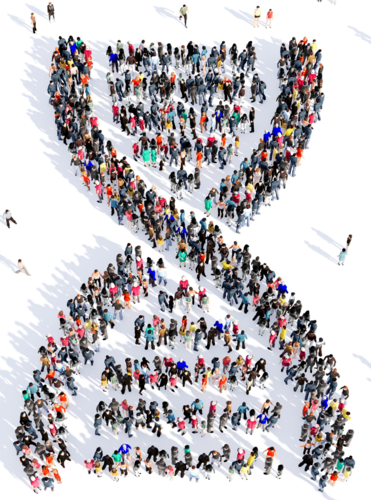The different kinds of lung cancer
Lung cancer is divided in non-small cell lung cancer (NSCLC, 85 % of all lung cancers) and small cell lung cancer (SCLC, 15 % of all lung cancers). NSCLC can be further classified into the main histological groups large-cell neuroendocrine carcinoma (LCNEC), squamous cell carcinoma (SQCC), and adenocarcinoma (ADC) ][1]. Adenocarcinoma is the most common NSCLC cancer, representing 35-40% of all lung cancers raising from small airway epithelial, type II alveolar cells, which secrete mucus and other substances, and it is frequently observed in persons who do not smoke.
Late diagnosis, difficult therapy
Lung cancer is a leading cause of cancer worldwide [2]. Most patients are diagnosed at late stages of the disease resulting in poor survival prognosis [3]. The 5-year overall survival of advanced NSCLC is about 26% in stage III and 10% to 1% in stage IV patients [4].
Depending on the lung cancer stage, patients can be subjected to surgery, radiation, chemotherapy, and/or targeted therapy [5]. Studies comparing the survival benefits between standard platinum-based chemotherapy versus immunotherapy have shown significant benefit of immunotherapy in the selected population of NSCLC patients both used as the first- or second-line therapies. However, immunotherapy does not show an expected benefit for all patients- only 20 to 25% of NSCLC patients positively respond. Why among patients exist this strong diversity, currently we are not able to answer.
Biomarkers indicate therapy response
One of the aims of Prof. Janciauskiene's group is to search for potential biomarkers which can help to predict/determine patient`s response to the therapy or an appropriate sequence and/or combination of chemotherapy with immunotherapy.
Peripheral blood is a minimally invasive source of potential biomarkers including acute phase proteins (APPs). Blood concentrations of APPs are changing during lung cancer development, and although these proteins are nonspecific inflammatory markers, they seem to have clinical value. To date, various reports suggest that single APPs have a profound impact on cancer development and body’s innate immune system, however a putative prognostic value of combined serum APPs in NSCLC patients has not been explored. The DZL scientistsanalysed serum samples from 139 NSCLC patients prior to anti-PD-1 or anti-PD-L1 therapies to assess whether baseline levels of albumin (ALB), alpha-1 acid glycoprotein (AGP), alpha1-antitrypsin (AAT), alpha2-macroglobulin (A2M), ceruloplasmin (CP), haptoglobin (HP), alpha1-antichymotrypsin (ACT), serum amyloid A (SAA), and high-sensitivity C-reactive protein (hs-CRP), have a predictive value for immunotherapy success. A multivariate Cox regression analysis, including serum levels of APPs and clinical parameters, revealed that higher pre-therapeutic levels of AGP, HP, AAT, and CP but lower levels of ALB are independent predictors of a worse survival. Moreover, a combined panel of AGP, HP, AAT, CP, and ALB stratified patients into responders and non-responders. If confirmed in an independent and a larger sample set, this panel can be clinically valuable predictive marker for NSCLC patient response to targeted therapy. In general, the analysis of APPs is non-invasive and reliable method, available in all clinical chemistry laboratories, suggesting its high potential [7].
Influence and interaction between acute-phase-proteins and tumors
A second aim of Prof. Janciauskiene's project is to study the crosstalk between inflammation, innate immunity and lipid metabolism in lung cancer progression and resistance to therapy. They specifically focus on the influence of APPs like AAT on the interactions between tumor and tumor-associated cells. [figure 1]
Inflammation triggered by bacterial and viral infections or by tobacco smoke are known to increase risk for NSCLC. On the other hand, an intrinsic inflammatory response triggered by cancer itself may establish a pro-tumorigenic microenvironment. Cancer cells usually show different metabolic patterns compared with healthy cells. Among others, lipid metabolism undergoes changes in cancer cells, often leading to the accumulation of lipid droplets, organelles involved in cell proliferation, apoptosis, lipid metabolism, stress, immunity, signal transduction and protein trafficking.
The group specifically focuses on the potential association between lipid droplets and drug resistance in lung cancer models. Theystudy mechanisms and implications of lipid droplet accumulation in cancer cells resistance against apoptosis and other forms of death.
Under inflammatory conditions NSCLC also express various APPs, like AAT, and can secrete these proteins into microenvironment. Likewise, exogenous APPs, like AAT, interact with cancer and innate immune cells, and dependent on cell activation status modulate signalling pathways and release of pro-and anti-inflammatory substances into microenvironment.
AAT is particularly important anti-protease in the lungs, and persons with severe inherited AAT deficiency, especially smokers, have an increased risk of developing early-onset obstructive lung disease with emphysema. Even though lung cancer is linked with airflow obstruction and emphysema, AAT deficiency carriers seem not to be at higher risk of developing cancer. This points to undiscovered roles of AAT and other APPs in tumorigenesis.
Increased AAT-levels prevent cancer cell death
In line with findings from other research groups, our data support a notion that higher levels of AAT either due to the increased intracellular expression or external entry can prevent cancer cell death. In fact, intracellular entry of AAT occurs constitutively in all mammalian cells, including cancer cells. The intracellular endocytosis of AAT may depend on the pathways non-involving lipid rafts, namely clathrin-mediated endocytosis, or pathways that take place in lipid rafts, which include caveolae-mediated endocytosis and flotillin-dependent endocytosis [8]. Janciauskiene's grouphypothesizes that the uptake and subcellular trafficking of AAT might strongly depend on its concentration and the activation status of the cells. Hence, to improve understanding regarding the role of AAT in tumorigenesis, intracellular entry, and processing of AAT, but also other APPs, by cancer cells cannot be denied and we aim for detailed investigations.
Finally, it is important to keep in mind that APPs can modulate activities of other cells acting within tumor microenvironment. Previously, it has been reported that AAT stimulates fibroblast proliferation and extracellular matrix production and affect leukocyte profiles associated with inflammatory resolution and tissue regeneration and to promote macrophage polarization towards the pro-tumorigenic M2-like profile[8].
Acute-phase-proteine affect cancer
Based on the current knowledge, one can conclude that the involvement of AAT as well as other APPs in cancers can be direct (on cancer cells) or indirect (via cancer associated cells). APPs may form pro- or anti-cancer host defense response, which needs to be taken into consideration for designing cancer treatments. In our future work will determine whether some of the APPs contribute to and/or reflect cancer development, and representing potential therapeutic targets and/or biomarkers in tumorigenesis.
[figure 1]: Schematic representation of the role of alpha1-antitrypsin (AAT): AAT is involved in immune regulation, lipid metabolism and the development and growth of cancer cells [9-19]
Text: Working Group S. Janciauskiene
Foto: BREATH
Graph: S. Wrenger
[1] Devesa SS, et al. International lung cancer trends by histologic type: male:female differences diminishing and adenocarcinoma rates rising. Int J Cancer 2005: 117(2): 294-299.
[2] Torre LA, et al. Global cancer statistics, 2012. CA Cancer J Clin 2015: 65(2): 87-108.
[3] Hardtstock F, et al. Real-world treatment and survival of patients with advanced non-small cell lung Cancer: a German retrospective data analysis. BMC Cancer 2020: 20(1): 260.
[4]Goldstraw P, et al. The IASLC Lung Cancer Staging Project: Proposals for Revision of the TNM Stage Groupings in the Forthcoming (Eighth) Edition of the TNM Classification for Lung Cancer. J Thorac Oncol 2016: 11(1): 39-51.
[5] Zappa C, et al. Non-small cell lung cancer: current treatment and future advances. Transl Lung Cancer Res 2016: 5(3): 288-300.
[6] Janke F, et al. Novel Liquid Biomarker Panels for A Very Early Response Capturing of NSCLC Therapies in Advanced Stages. Cancers (Basel) 2020: 12(4). [here unassigned]
[7] Schneider MA, et al. A panel of acute phase proteins as predictor for immunotherapy response in advanced NSCLC. Eur Respir J 2021: submitted.
[8] Janciauskiene S, et al. Potential Roles of Acute Phase Proteins in Cancer: Why Do Cancer Cells Produce or Take Up Exogenous Acute Phase Protein Alpha1-Antitrypsin? Front Oncol 2021: 11: 622076.
[9] Laurell CB. Is emphysema in alpha 1 -antitrypsin deficiency a result of autodigestion? Scand J Clin Lab Invest 1971: 28(1): 1-3.
[10] Ohlsson K, et al. In vivo interaction beween trypsin and some plasma proteins in relation to tolerance to intravenous infusion of trypsin in dog. Acta Chir Scand 1971: 137(2): 113-121.
[11] Janciauskiene SM, et al. The discovery of alpha1-antitrypsin and its role in health and disease. Respir Med 2011: 105(8): 1129-1139.
[12] Lewis EC, et al. Alpha1-antitrypsin monotherapy prolongs islet allograft survival in mice. Proc Natl Acad Sci U S A 2005: 102(34): 12153-12158.
[13] Johnson D, at al. The oxidative inactivation of human alpha-1-proteinase inhibitor. Further evidence for methionine at the reactive center. J Biol Chem 1979: 254(10): 4022-4026.
[14] Taggart C, et al. Oxidation of either methionine 351 or methionine 358 in alpha 1-antitrypsin causes loss of anti-neutrophil elastase activity. J Biol Chem 2000: 275(35): 27258-27265.
[15] Frenzel E, et al. Acute-phase protein alpha1-antitrypsin--a novel regulator of angiopoietin-like protein 4 transcription and secretion. J Immunol 2014: 192(11): 5354-5362.
[16] Karlsson H, et al. Protein profiling of low-density lipoprotein from obese subjects. Proteomics Clin Appl 2009: 3(6): 663-671.
[17] Subramaniyam D, et al. Cholesterol rich lipid raft microdomains are gateway for acute phase protein, SERPINA1. Int J Biochem Cell Biol 2010: 42(9): 1562-1570.
[18] Janciauskiene S, et al. Well-Known and Less Well-Known Functions of Alpha-1 Antitrypsin. Its Role in Chronic Obstructive Pulmonary Disease and Other Disease Developments. Ann Am Thorac Soc 2016: 13 Suppl 4: S280-288.
[19] Al-Omari M, et al. Acute-phase protein alpha1-antitrypsin inhibits neutrophil calpain I and induces random migration. Mol Med 2011: 17(9-10): 865-874.
Projektleitung: Janciauskiene, Sabina (Prof. Dr. rer. nat. Dr. pharm.) MHH Klinik für Pneumologie; Förderung: Deutsches Zentrum für Lungenforschung (DZL), Biomedical Research in End-stage and Obstructive Lung Disease Hannover (BREATH)
Text: AG Janciauskiene
Figures/ pics: AG Janciauskiene/ BREATH


Prof. Dr. rer. nat. Dr. pharm. Sabina Janciauskiene, Department of Respiratory Medicine at MHH, Pricipal Investigator at the German Center for Lung Research (DZL) at site BREATH (Hannover)